
<< Back | Home | Site Map
Origin of name: Aboriginal - flat stones used to crush seeds.
Station opened: 27-6-1925
Distance from Melbourne (via Castlemaine): 364 miles 9 chains 71 links; 585.996 km
Distance from Melbourne (via Ballan): 592.900
Height above Sea Level: 119 feet
During construction there was no official name for the station site, the survey having been altered from the original site of Yelta on the Victorian side of the Murray River, opposite Wentworth. With the decision to alter the original survey to a point exactly one mile from the bridge being constructed over the Murray River at Abbotsford under the Border Railway Act, the new station site was referred to as "6 Mile Siding". The name "Abbotsford" was used during the actual construction period and the name Yelta was applied with the opening of the line. A type "C' station was originally planned, then altered to be a shelter shed, and finally a type "A" station building was provided.
The extension of the line from Merbein to Yelta was opened on 27-6-1925. A 250 feet long passenger platform with cart dock with a "Type A" 20 x 12 feet station building, telephone, closet and urinal. A 12 x 10 feet van goods shed was also provided. A run-around loop with a dead-end extension at the up end was provided and a goods loop siding with a 30 x 15 foot goods shed together with a 50 x 16 foot goods platform. There were eight graded grain sites and a home signal provided.
An employee's cottage made of concrete blocks was provided adjacent to the passenger platform, with a caretaker in charge of the station appointed from 20-8-1925.
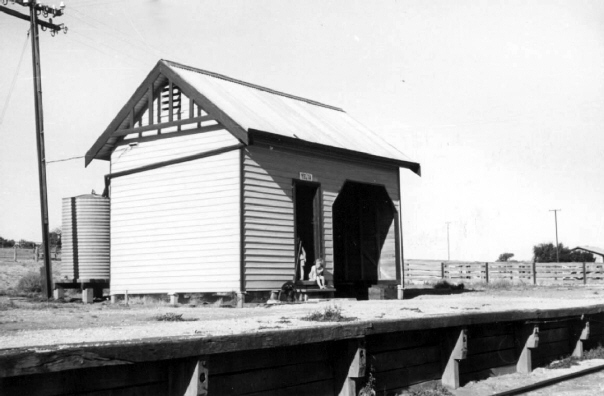
Yelta station in pristine condition 23-4-1957. Note the sheep race on the platform and the roof of the departmental residence in the right background. Photo: Doug. McLean, courtesy Bob Whitehead
In July 1925 consideration was being given to the construction of cattle and sheep trucking yards for transport of stock from the Darling River country, particularly as the nearby Abbotsford bridge over the Murray River was in the course of construction. Construction materials for the bridge were being conveyed by rail to Yelta. Material for construction of livestock yards was sent to Yelta, but later transferred to the Balranald line.
Chief Commissioner Clapp visited Yelta with his special inspection train on 24-8-1925. Breakfast was served in the dining car and an inspection made of the new terminus.
A deputation from the Pastures Protection Board met with railway officials Yelta on 3-6-1937 to request the provision of sheep trucking yards. Yelta was considered a natural outlet for the stock routes from the Lower Darling and Ana Branch districts of New South Wales. An inspection of the railway reserve considered the site ideal for the purpose. The Mildura Shire Council however, considered the trucking of stock from Yelta to Irymple for transfer to the abattoirs at Lake Benetook was ill considered. The Shire proposed that land could be easily made available for a branch line from Irymple to the abattoirs using rails from the unused portion of the Nowingi line and a tractor converted for rail operation used to supply motive power.
During his annual inspection visit in February 1938, the Chief Commissioner (Mr. Clapp), advised a deputation that, provided an assurance could be given that holding yards would be constructed in the vicinity of the station, he would investigate and ascertain what could be done to provide trucking facilities. It appears that nothing came of this until February 1947 when a meeting was held at Yelta between railway officials and representatives of pastoral interests. The station yard was inspected for establishing loading facilities and it was agreed these would be provided if stock companies provided holding and sale yards.
During World War 11, when Mildura airport was an advanced fighter training base for the RAAF, underground fuel tanks were built adjacent to the end of the line. Safe Working Register No.15 recorded that 300 feet of the dead end extension of the main line was for use as a fuel discharge siding. Aircraft fuel was pumped from rail tankers and later carted by road to the air base. The VR telephone from Mildura to Yelta was approved for use between the Mildura post office and the practice bombing range near Yelta station in December 1941. (Mildura airport was used as an RAAF training camp during World War 11).
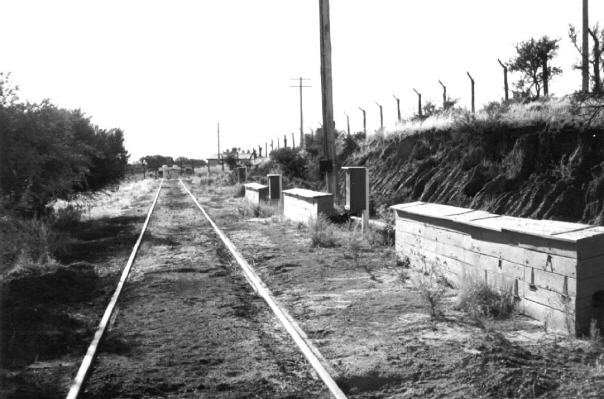
Fuel discharge facilities at the end of the line at Yelta on 23-4-1957. The underground fuel tanks were located in the sand hill to the right, surrounded by a defence force fence. Photo: Doug. McLean, courtesy Bob Whitehead
On 4-8-1949, rail tankers containing 37,000 gallons of oil arrived at Yelta. The oil was discharged to underground tanks formerly used by the RAAF and was used to spray coat at the Redcliffs pumping station to increase the heat output. The oil was transferred from Yelta to the Redcliffs pumps by road transport.
In August 1953 instructions were issued that that the down end of the platform road (end of the main line) may be used as a siding for the New South Wales Water Conservation and Irrigation Commission.
A full time porter was appointed to handle wool consignments in August 1954 in an endeavour by the Commissioners to improve facilities to wool growers during the wool season. A member of the Mildura station staff was on duty from 8 a.m. to 5 p.m. Monday to Friday inclusive.
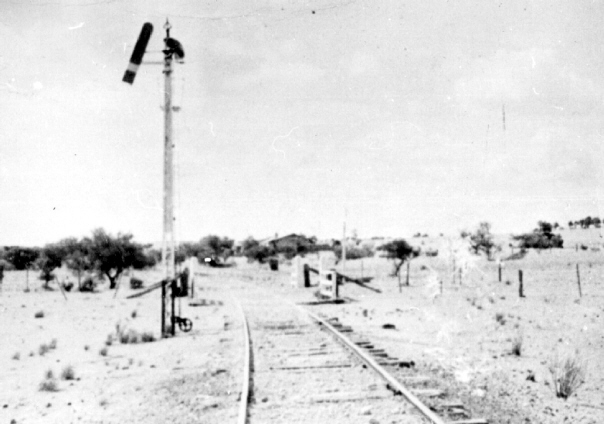
The home signal at Yelta. The departmental residence can be noted in the background. 1955. Photo: Des Jowett
The down home signal was removed on 20-6-1967.
Yelta was worked under no one in charge conditions supervised by Mildura by 17-4-1973.
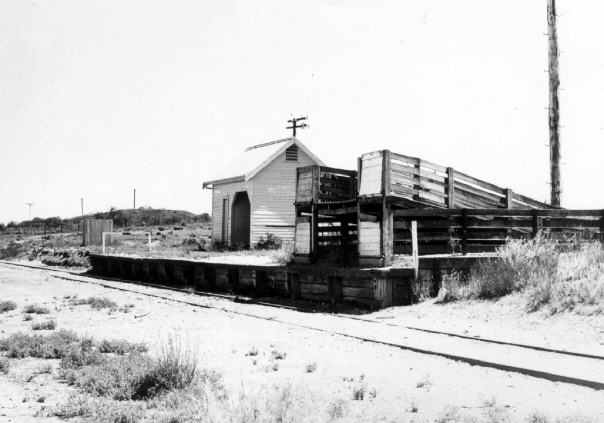
Yelta station showing the sheep loading facilities on the platform. 17-11-1973. Photo: Bruce McLean
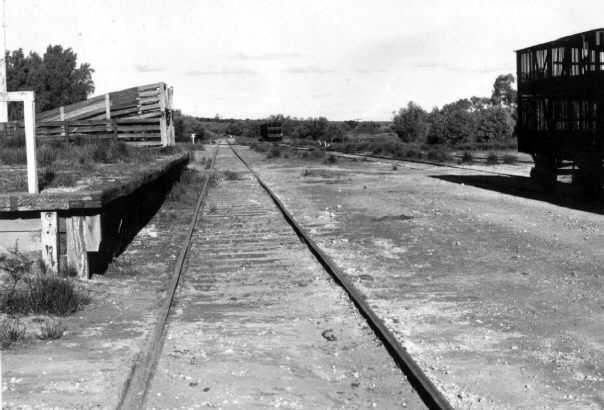
Looking in the Up direction at Yelta on 9-6-1974. Note the sheep race shares the passenger platform. Photo: Bruce McLean
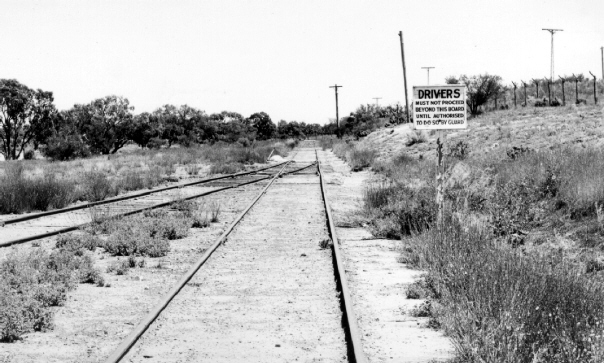
Down end of Yelta looking towards the end of the line on 17-11-1973. The fuel discharge facilities have been removed although the fuel bunkers remained buried under the hill at right behind the wire fence. Photo: Bruce McLean
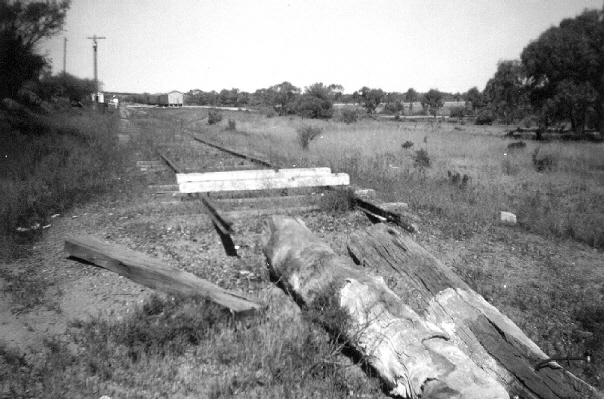
End of the Woomelang to Mildura and Yelta line - the northern most point on the Victorian Railways network - in 1968. The buffer stop has collapsed and been replaced by a baulk. The goods shed on the loop siding can be observed in the background. Photo: Bruce McLean
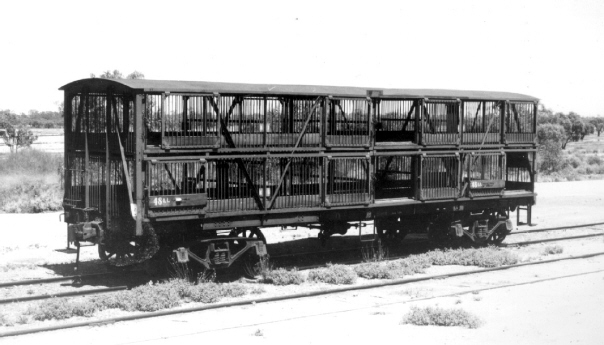
48LL bogie sheep wagon at Yelta. 17-11-1973. Photo: Bruce McLean
It was suggested in July 1977 by Mr. W. Boulton, Chairman of the Millewa area silos committee, that a 100,000 bushel silo at Yelta would satisfy the expansion of wheat growing in the south west of New South Wales, north of Wentworth. The silo would also serve the Merbein South-Wargan wheat growing areas and justify the retention of the Merbein to Yelta railway which was dependent on stock traffic. On 13-6-1978, the Chairman of the Grain Elevators Board (Mr. K. Gross) met at the station with farmers, municipal leaders from Mildura City, Mildura Shire and Wentworth Shire councils and Mr. K. Wright M.L.C. to discuss the proposal for this grain to be transported on the Victorian railway system. It was suggested by the Board that wheat could be loaded straight into rail trucks at Yelta in the same way as it had been done successfully at Cowwarr, near Sale, for three years.
In July 1978, the Grain Elevators Board (G.E.B) notified Wentworth Shire Council that it was quite feasible to establish grain receival facilities for the benefit of farmers in New South Wales at Yelta. Mildura Shire Council also communicated with Wentworth Shire to see if they would be prepared to share the cost of installing a weighbridge at Yelta. Wentworth Shire Council agreed to support the concept of a Yelta grain facility but did not commit itself to financial support.
A co-operative company was formed by Wentworth area graziers to arrange finance of $20,000 to build a weighbridge but it was conditional upon full municipal support and a guarantee that the Yelta line had a future. The G.E.B. sought an assurance from the Victorian Railways Board that the line would be kept open for two wheat seasons so that direct loading of wheat into rail trucks and an accurate assessment of production could be made. Work commenced in November 1978 to install a weighbridge, grain augers and erect three galvanised 12 gauge iron silos alongside the loop siding at the down end beyond the goods shed.
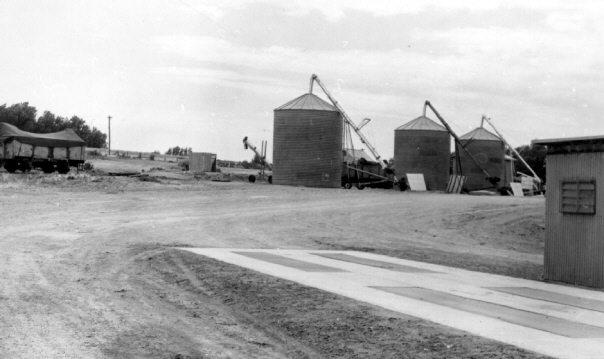
The new weighbridge and silos at Yelta. 26-11-1978. Photo: Bruce McLean
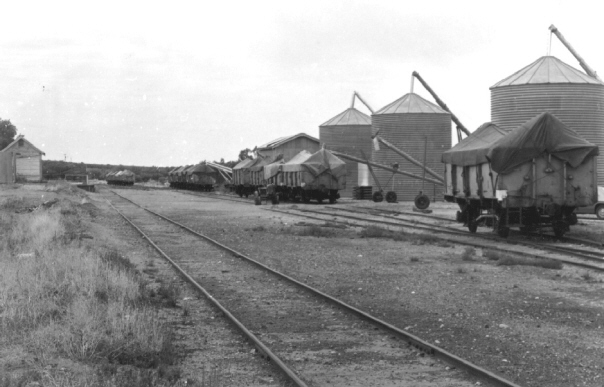
The "new look" Yelta with temporary silos and augers feeding grain from the lower Darling River country into the Victorian rail grain handling system. 26-11-1978. Photo: Bruce McLean
The goods shed was demolished by bulldozer at the end of February 1979 to provide unloading space for gravel carried by rail from Carisbrook for the New South Wales Department of Main Roads and Wentworth Shire Council. The area usually used for unloading gravel was taken up by the temporary grain silos.
In May 1979 the Shire of Mildura received advice that the G.E.B. had applied to the Victorian Railways Board to erect silos at Yelta as part of a plan to built ten new storages in the State. The railway department also confirmed that it had reconsidered closing the Merbein to Yelta section as conditions regarding line usage had changed.
To meet the problems being experienced with the storage of grain crops following an exceptional season and faster harvesting techniques being employed by grain farmers the Grain Elevators Board constructed a ground bunker in 1979. The bunker was filled by mid-December causing many New South Wales growers to transport their crops to Carwarp.
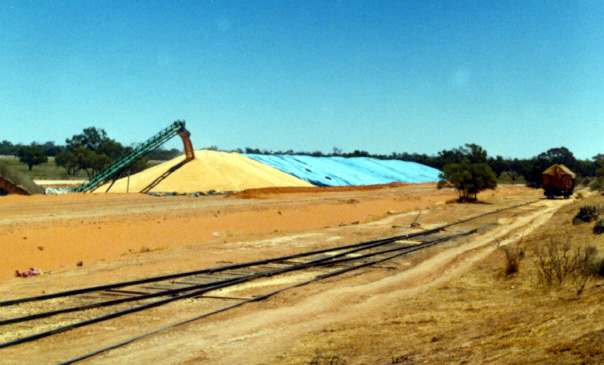
Filling the bunker constructed for the 1979 harvest, at Yelta. The GY wagon is standing near the end of the line. 13-12-1980. Photo: Bruce McLean
In August 1980 the G.E.B. announced the acceptance of a tender for the construction of two 13,600 tonne silos and an elevator. Construction commenced in September 1980 and the $1.2 million facility was officially opened by the Chairman of the Grain Elevators Board (Mr. K. Gross) on 12-10-1981.
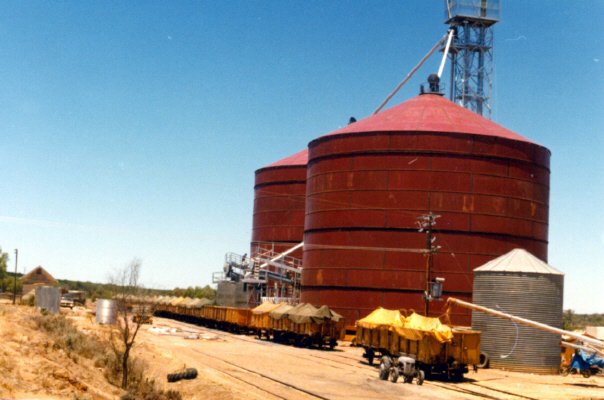
The new silos at Yelta were ready for the 1980 harvest with loading activity at both the new silos and one of the temporary silos put into place in 1978. This scene was taken on 13-12-1980 the day after the official opening. Photo: Bruce McLean
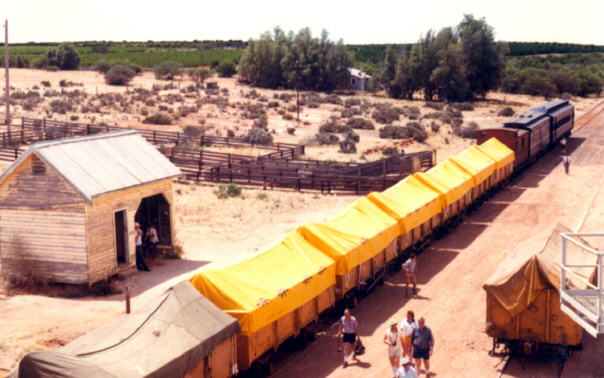
A grain train hauled by T368 has arrived at Yelta with a group from the Australian Railway Exploration Association. Their special carriages "Carey" and Sleeper No.5 were attached to the rear of the train. Of interest in this view from the silo are the stock races on the station platform and the departmental residence in the tall trees in the background. 30-12-1981. Photo: John R. Page
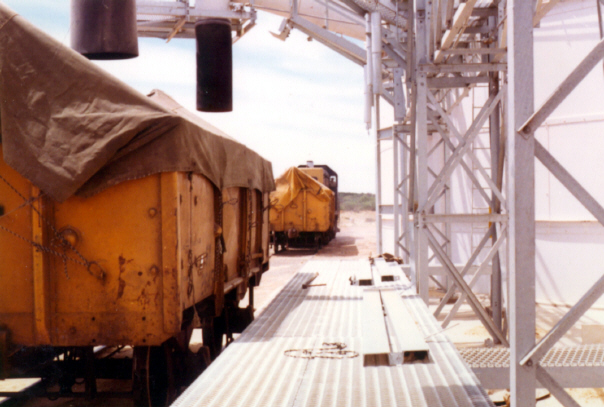
The loading chutes at the new silos at Yelta. T368 is shunting wagons in the background. 30-12-1981. Photo: Bruce McLean
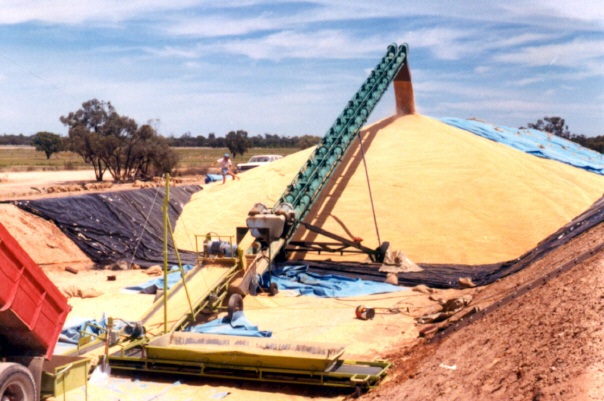
Filling the Yelta bunker during the 1981/82 harvest. 30-12-1981. Photo: Bruce McLean
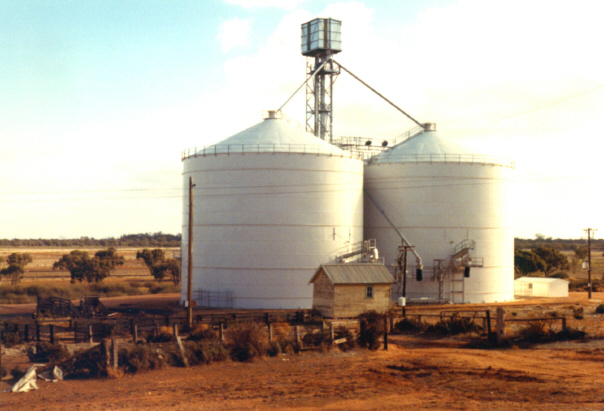
The scene at Yelta on 19-6-1982 showing the station building in centre, stock loading ramps to the left and steel silos. Photo: Bruce McLean
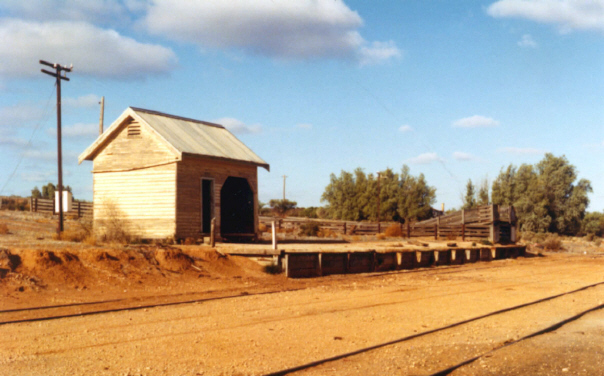
Yelta station and stock loading facilities on platform. 18-6-1982. Photo: Bruce McLean
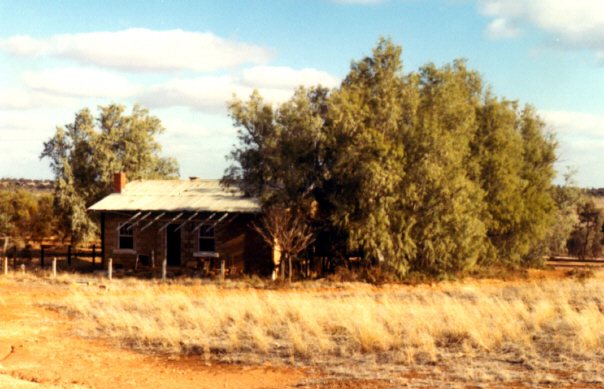
Departmental residence at Yelta as seen on 19-6-1982. By this date, the cottage was no longer occupied. Photo: Bruce McLean
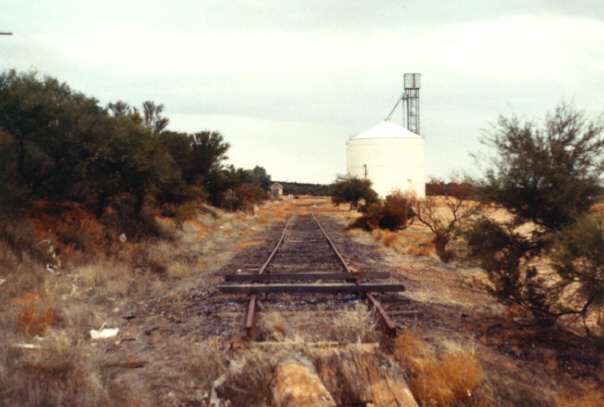
The "end of the line" photo was always tempting during a Yelta visit. Comparison with "end of the line photos" shows the dramatic developments that re-shaped and gave Yelta a new future. 6-7-1982. Photo: Bruce McLean
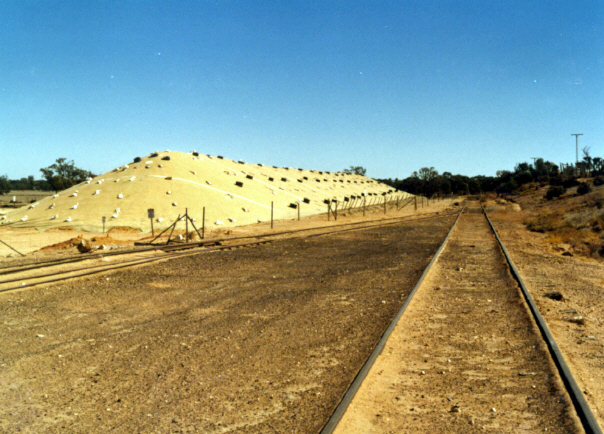
The end of the line at Yelta with the grain bunker covered and secured. 13-4-1986. Photo: Bruce McLean
V/Line announced that it was discontinuing livestock traffic from 1-10-1986. Mildura livestock agent, Mr. B. Bawden, criticised the move saying that V/Line was not catering for the small farmer. He could not understand why other States were continuing with livestock traffic whilst V/Line had rolling stock that would now be sitting in sidings instead of earning revenue.
Member for North Western Province, Mr. K. Wright, also attacked the decision. He claimed that with rail competition gone, road transport freight rates had already been increased. Mr. Wright said that in years gone by entire train loads of livestock had been railed from country saleyards after sales and during droughts the rail system had been used to cart stock to agistment in huge numbers. V/Line claimed that livestock represented only 1% of revenue, however Mr. Wright said that business had been considerably reduced because V/Line had imposed minimum carrying limits of up to 20 wagon loads.
In reality it was clear that V/Line had set out to make it impossible for this traffic to continue or grow. By 1983, only ten bogie cattle wagons remained in service, which was equal to 20 four-wheel wagon loads. In other words, the entire V/Line livestock wagon fleet would have to be used for a rail transport order out of Yelta.
In 1987 it was announced that the Mildura to Yelta line would be upgraded to handle heavy bogie grain wagons, but before the line upgrading had commenced, V/Line decided to get in early and send some bogie VHGY grain wagons to Yelta for a special despatch of safflower from the Yelta silos. The first VHGY wagons were taken out on the line on 11-4-1987, with the siding at Merbein being used to hold some of the wagons.
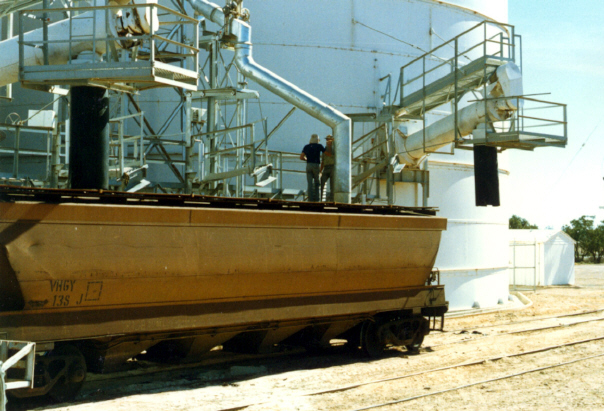
The first use of VHGY wagons at the Yelta silos for loading of safflower. 11-4-1987. Photo: Bruce McLean
The stock race on the station platform was noted demolished by 29-5-1988.
The upgrading and relaying of Yelta saw the whole of the old track arrangement removed, the site graded and a new track arrangement with new sleepers and the heavier 80 pound rail laid. This work commenced in September 1988.
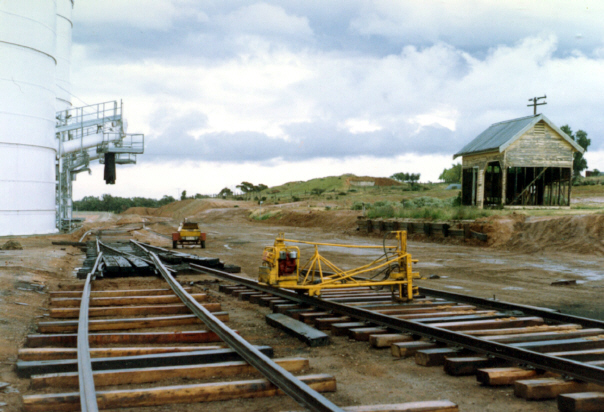
The whole track arrangement at Yelta was altered when the relaying gang started work. All existing track work was removed, the site graded and a new track arrangement constructed. In this view looking in the down direction, the down end points of the loop are ahead of the grain discharge chutes. The platform and derelict station building indicate the former position of the main line. 1-10-1988. Photo: Bruce McLean
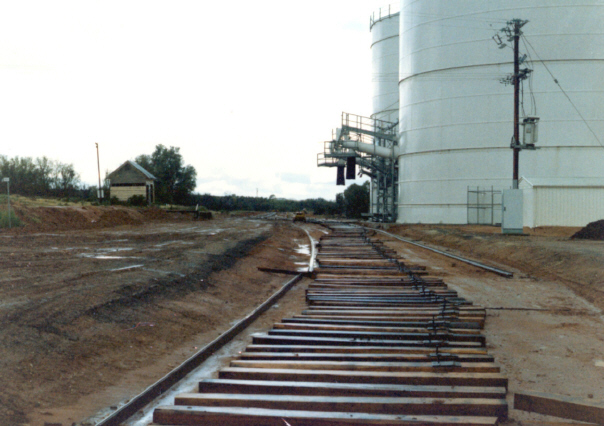
Looking in the Up direction at the new track arrangement. Note the isolated station platform. 1-10-1988. Photo: Bruce McLean
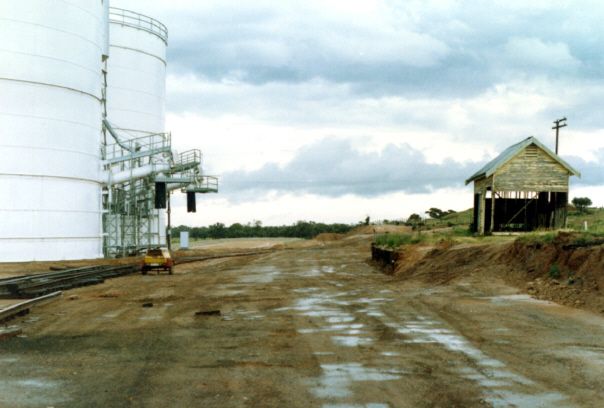
The new design for the terminus at Yelta was solely directed at grain requirements, therefore there was no consideration given to retaining the platform alignment in the planning process. 1-10-1988. Photo: Bruce McLean
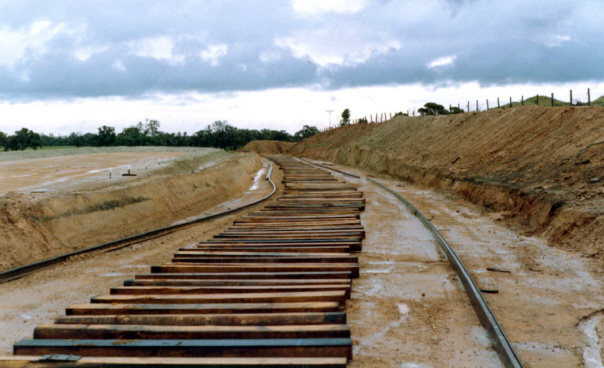
Looking towards the end of the line at Yelta. The last section of track under the new arrangements curved back to end up on the old alignment a short distance from the site of the old buffer stop. 1-10-1988. Photo: Bruce McLean
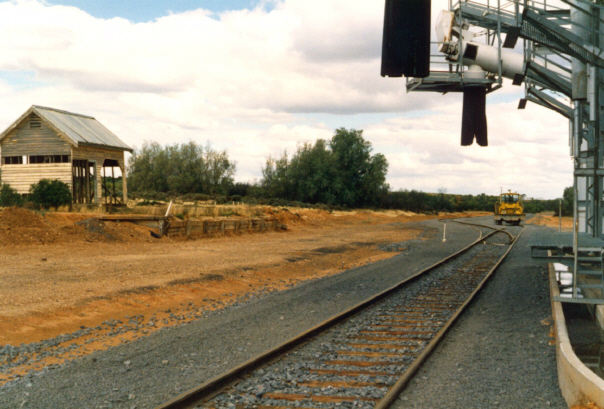
The new track arrangements at Yelta following ballasting. Note the isolated station platform and building. 1-10-1988. Photo: Bruce McLean
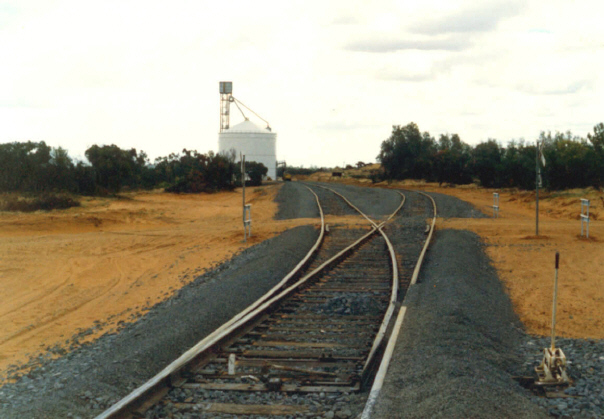
The Up end of Yelta yard following ballasting. A light metal has been placed beside the rails to form a smooth path for workers and crews attending to rolling stock and safeworking. 1-10-1988. Photo: Bruce McLean
The partly upgraded Mildura to Yelta line was open for traffic after a temporary closure, on 6-10-1988. More than 1500 tonnes of grain was loaded at Yelta on 6-10-1988 and another 1125 tonnes the following day. The section from Merbein to Yelta had not been completed and a speed restriction of 25 kph applied.
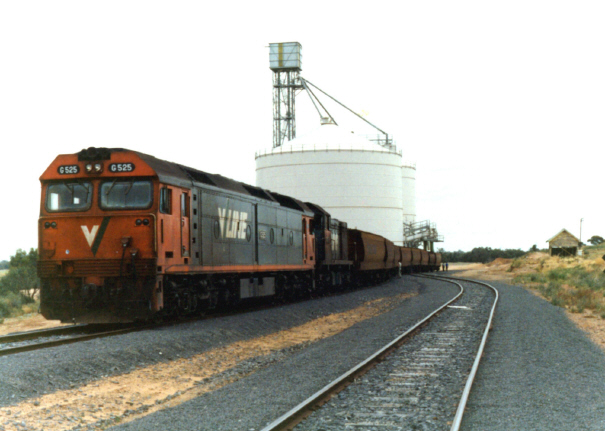
G525 & T380 stand at the head of a grain train at Yelta. The sight of a G Class locomotive and a train of bogie grain hoppers became the standard train pattern at Yelta. 19-10-1989. Photo: Bruce McLean
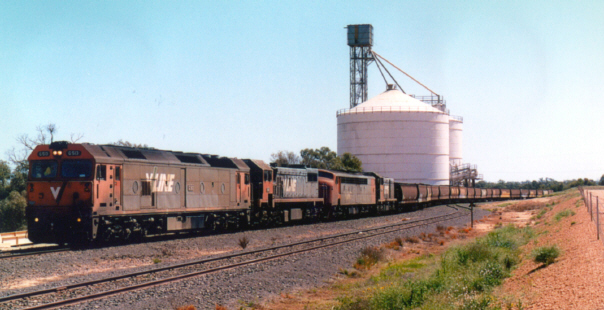
G513, X44, S301 and T402 present a formidable line-up of locomotive power as they head up a rake of grain wagons being filled at the Yelta silos. 17-9-2000. Photo: Bruce McLean
The 2001/2001 harvest was a record yield with reported receivals totalling 4.9 million tonnes which saw many sites particularly in northern Victoria and the Mallee smash daily receival records at peak periods. GrainCorp recorded that on third of the harvest was received by the 13 largest facilities, including Yelta (104,910 tonnes).
| << Back | Home | Site Map | Copyright © 2003 Bruce McLean, All Rights Reserved |